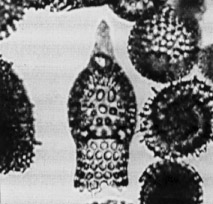 Pterocodon
ampla (Brandt)
Pterocodon
ampla (Brandt) Pterocodon
ampla (Brandt)
Pterocodon
ampla (Brandt)Theocyrtis ampla Brandt in Wetzel, 1935, p.56, pl.9, figs.13-15
Pterocodon(?) ampla (Brandt), Foreman, 1973, p.438, pl.5, figs.3-5
Shell subcylindrical, of three segments, with relatively smooth surface and ragged distal margin. Cephalis subhemispherical with no, or a few, small, circular pores; bearing a sturdy, moderately long cylindro-conical horn with a roughened tip, or roughened overall. Collar stricture not very well defined externally, with a vertical pore, and with four collar pores internally. Thorax subhemispherical with regular circular to subcircular pores arranged quincuncially in transverse rows. Abdomen cylindrical with diameter equal to or less than that of thorax. Lumbar stricture may or may not be expressed externally; internally a distinct septum that varies considerably in thickness among individual specimens; thick on specimens with abdominal pores smaller or equal in size to those of the thorax, thin on specimens with abdominal pores larger. There is some tendency towards segmental division of the abdomen. Pores circular to subquadrangular, generally transversely aligned, fairly uniform in size and shape on individual specimens but varying considerably among them (Foreman, 1973).
Based on 50 specimens. Length overall, exclusive of horn, 150-210 Ám. of cephalis and thorax 80-100 Ám; greatest width of thorax 60-90 Ám (Foreman, 1973).
P. ampla is distinguished from P. lex Sanfilippo and Riedel (1979, p.505, pl.1, figs.9-10) by its larger size (the length of cephalothorax being more than 80 Ám), and from P. tenellus Foreman (1973, p.439, pl.5, fig.7, pl.12, fig.4) by the more expanded thorax, the larger, less numerous pores and the better developed lumbar septum. Calocyclas talwanii Bj°rklund and Kellogg (Bj°rkund, 1976, pl.21, figs.1-3) is larger (Sanfilippo et al., 1985).
Variable features are the number of pores on the cephalis (from none to about ten), the robustness and length of the cylindro-conical horn, and degree of widening of the skeleton distally. When the horn is robust it completely encloses the cephalis, and the collar stricture thus is not well defined externally. The lumbar stricture, internally, is a distinct septum that varies in thickness, being thick in specimens with abdominal pores small or equal in size to those of the thorax, thin in specimens with larger abdominal pores. Abdomen, varying in length, has an undifferentiated margin and a tendency to segmental division. The pores are circular to subquadrangular, transversely aligned, varying in size and shape between specimens (Sanfilippo et al., 1985).
P. ampla ranges across the Paleocene/Eocene boundary. It has been found in northern Europe, the tropical Pacific, the Gulf of Mexico and the Caribbean. Its morphotypic first appearance lies within the Bekoma campechensis Zone and its morphotypic last appearance lies within the Buryella clinata Zone.
Pterocodon ampla evolved from P. lex.
Additional illustrations can be found in Sanfilippo and Riedel, 1979, pl.1, figs.7-8.